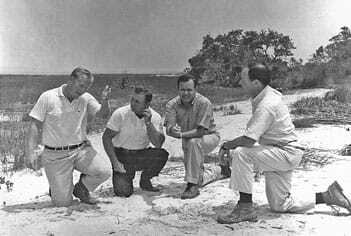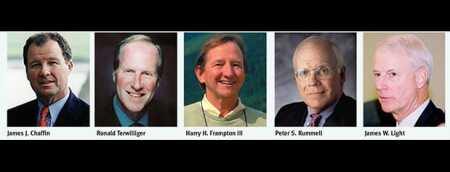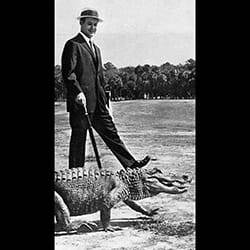In 1973, during a speech to the Atlanta chapter of the Financial Analysts Society, Sea Pines Company owner Charles Fraser speculated on the ramifications of America’s oil crisis for the resort industry. He described the company’s sensitivity to rising gas prices, including a variety of on-site offerings at the Sea Pines communities minimizing the need for vacationers and residents to drive once they arrived:
“It is our current assessment that our communities and operations can be adapted with reasonable comfort to the high-priced energy world ahead, and that any dislocations of our markets will be temporary and offset within a few months by new marketing strategies, transportation planning, and facility construction attuned to slower auto speeds and costly fuel. We will work harder. . . . The company will accelerate plans in each of these communities to have available 20 mph electric cars as an important means of guest, convention, and resident movement . . . along with shuttle buses. We will push for prompt use of any technological breakthroughs in solar heating, wind power generation, better insulation, and other means of coping with the energy crisis.”
Fraser’s commitment to development practices that preserved the environment and conserved energy distinguished his communities—from Sea Pines Plantation on Hilton Head to Palmas del Mar in Puerto Rico—as cutting edge. To those who worked for him, embracing the unconventional was the standard for working at Sea Pines—a pursuit typical of a man who learned from others’ work and ideas and kept abreast of every trend and phenomenon that might affect real estate.
With an inclination for hiring the young and entrusting them with much responsibility, Fraser employed many budding real estate professionals who eventually became accomplished leaders in both the industry and ULI, including four who became ULI chairmen: James J. Chaffin, chairman of Chaffin Light Management in Okatie, South Carolina; J. Ronald Terwilliger, chairman emeritus, Trammell Crow Residential, Dallas, Texas; Harry H. Frampton III, managing partner, East West Partners–Western Division, Avon, Colorado; and Peter S. Rummell, principal, the Rummell Company, Jacksonville, Florida.
A highlight of ULI South Carolina’s annual meeting at Hilton Head was a panel featuring Chaffin, Terwilliger, Rummell, and former ULI trustee James W. Light, chairman of Chaffin Light Management in Basalt, Colorado, who also worked for Fraser in Sea Pines’ early years. Each reflected on his experience during a panel moderated by former ULI trustee and Fraser protégé Diana Permar, president of Permar Inc. in Kiawah Island, South Carolina.
“Charles had a voracious appetite for knowledge,” said Chaffin, who described receiving endless stacks of “must read” files from his boss. “He was constantly tearing articles out of magazines; reading fed his creativity. He was inspired by what he saw and read. He was always digging for new information, and he made sure we saw it and were prepared to use it.”
Light recalled Fraser sending him on intelligence-gathering missions to James Rouse’s master-planned community of Columbia, Maryland, and to Country Club Plaza in Kansas City, Missouri, developed by ULI founder J.C. Nichols. Fraser “was avid about getting out and seeing what else was going on,” Light said. “He would ask people their opinions, and his ideas would evolve from that.”
“Charles knew that good ideas can come from anywhere,” Rummell said. “He would really pay attention; he listened to everyone. He taught us that new ideas don’t come from traditional sources and that you don’t just blindly go where the last person was.”
Terwilliger noted Fraser’s curiosity. “Charles was never satisfied with doing something the way it always had been done,” Terwilliger said. “He instilled in all of us the importance of being curious, to be expansive in the way we think, to get out there and find out what the new ideas are.”
Fraser’s impact on real estate could be compared to the imprint that late Apple chief executive Steve Jobs had on communications, Terwilliger said. By designing communities with bike paths and minimal tree cutting, Fraser “created something people had not seen before. He conceived of what the customer would want before they knew they wanted it,” he said.
Light said Fraser’s focus on the mission he established for the company was an inspiration. “Charles was absolutely clear about what he was doing with Sea Pines. He wanted buyers to know what he was committed to, that he was setting aside a substantial amount of land [more than one-quarter of the acreage at Sea Pines Plantation] for open space. The environment was part of his product. That clarity of mission made it a very appealing place to work.”
Fraser introduced his employees to ULI by insisting that they attend the institute’s major events, particularly the annual fall meetings, instilling a loyalty that they passed on to their own staff members. “Charles was passionate about ULI, and it was expected that if you worked for him, you would join ULI. It became part of our DNA,” Rummell said. “He saw ULI as a window into what was going on in other places. It was an efficient way for him to hear about what other people were doing.”
“Charles was a sponge,” added Chaffin. “ULI was the one place he could go to soak up knowledge and put it into practice.”







